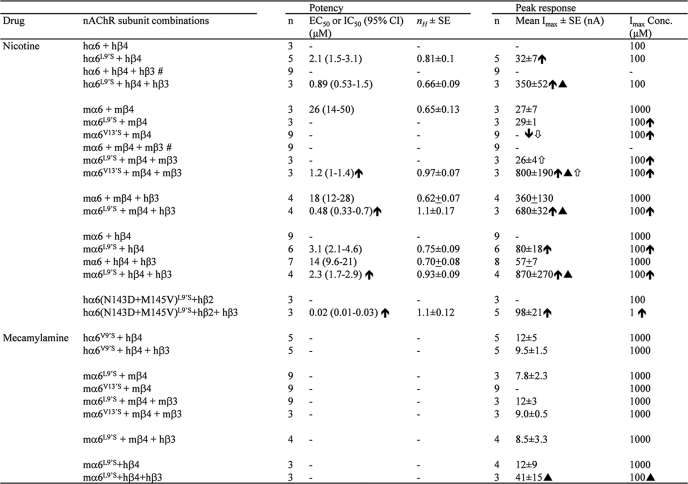TABLE 1.
Parameters for agonist or antagonist action at nAChR containing gain-of-function α6 mutant subunits
Potencies (micromolar EC50 or IC50 values with 95% confidence intervals), Hill coefficients (nH ± S.E.), mean ± S.E. efficacies (two-electrode voltage-clamp peak responses, Imax, in nanoamperes), and concentrations where maximal peak current amplitudes (Imax concentration in micromolar) are achieved (μm) are provided for nicotine as an agonist or mecamylamine as an antagonist acting at nAChR composed of the indicated subunits derived from the specified species and from the indicated number of independent experiments (n) based on studies as shown the figures. Closed up arrows or closed down arrows indicate a significant (p < 0.05) increase or decrease, respectively, in potency or efficacy of the indicated agent at the indicated nAChR subtype relative to nAChR containing the wild type α6 subunit. Filled triangle indicates a significant increase in indicated agonist or antagonist potency or efficacy at the indicated nAChR containing α6L9′S or α6V13′S subunits relative to the same complex but lacking β3 subunits. Open up arrows or open down arrows indicate a significant increase or decrease, respectively, in potency or efficacy of the indicated agonist at the indicated nAChR containing α6V13′S subunits relative to nAChR containing α6L9′S subunits. Note that no or very rare and then small responses to nicotine were seen for the following subunit combinations (n = 6–9 each): hα6 or hα6L9′S plus hβ2 alone or with hβ3; mα6 or mα6L9′S or mα6V13′S plus mβ2 alone or with mβ3 or hβ3; and mα6 or mα6L9′S plus hβ2 alone or with hβ3. - indicates that absent or inconsistent functional responses in two-electrode voltage-clamp studies precluded determination of the parameter of interest; # indicates data from (4).

